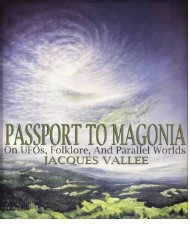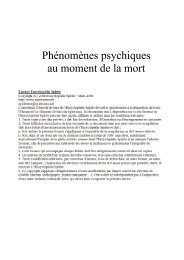extraordinary%20encounters
extraordinary%20encounters
extraordinary%20encounters
Create successful ePaper yourself
Turn your PDF publications into a flip-book with our unique Google optimized e-Paper software.
4 Abductions by UFOs<br />
tion. Few observers believed that conscious<br />
hoaxing played much of a role in abductionreporting.<br />
Unlike contactees, abductees seldom<br />
had any background in occultism or esoteric<br />
interests, and hardly any sought profit or<br />
publicity. To every indication they believed<br />
that they had undergone frightening, bizarre<br />
experiences. Some psychological studies<br />
found that abductees often evinced all the<br />
symptoms of post-traumatic stress disorder of<br />
the sort ordinarily associated with victims of<br />
crime, personal assault, or other threatening<br />
terrors.<br />
In 1987 Thomas E. Bullard, author of an<br />
Indiana University Ph.D. dissertation on the<br />
relationship of UFOs to folklore, released a<br />
two-volume study of all abduction accounts<br />
then known, some three hundred. Through a<br />
searching examination of the narratives,<br />
Bullard concluded that a real phenomenon of<br />
strikingly consistent features existed, that “abductions”<br />
were not simply an assortment of<br />
random fantasies. He noted patterns that had<br />
escaped even the most attentive investigators,<br />
including “doorway amnesia”—the curious<br />
failure of abductees to remember the moment<br />
of entry or departure from the UFO. Besides<br />
establishing the uniform nature of hypnotic<br />
and non-hypnotic testimony, Bullard determined<br />
that the phenomenon’s features remained<br />
stable from investigator to investigator,<br />
thus casting doubt on a favorite skeptical<br />
argument concerning investigator influence<br />
on the story. Beyond that, Bullard wrote, it<br />
was difficult to say more, except that “something<br />
goes on, a marvelous phenomenon rich<br />
enough to interest a host of scholars, humanists,<br />
psychologists and sociologists alike as well<br />
as perhaps physical scientists, and to hold that<br />
interest irrespective of the actual nature of the<br />
phenomenon” (Bullard, 1987).<br />
Hopkins’s next book, Intruders (1987), introduced<br />
fresh features that would figure<br />
largely in all subsequent discussions. From his<br />
latest investigations he had come to suspect a<br />
reason for alien abductions: the creation of a<br />
race of hybrid beings to replenish the extraterrestrials’<br />
apparently exhausted genetic stock.<br />
Female abductees would find themselves pregnant,<br />
sometimes inexplicably; then, following<br />
subsequent abductions involving vaginal penetration<br />
by a suction device, they would discover<br />
that those pregnancies had been suddenly<br />
terminated. In later abductions they<br />
would be shown babies or small children with<br />
both human and alien features. The abductors<br />
would explain that these were the women’s<br />
children. Hopkins also uncovered a pattern of<br />
cases of sexual intercourse between male abductees<br />
and more-or-less human alien women<br />
(perhaps adult hybrids).<br />
Other investigators began finding similar<br />
cases. Hybrids were a new wrinkle, significantly<br />
augmenting the already considerable<br />
peculiarity of the abduction phenomenon. As<br />
long ago as 1975, in his book The Mothman<br />
Prophecies, investigator John A. Keel noted, in<br />
passing, a pattern of what he called “hysterical<br />
pregnancies” in young women who had had<br />
close encounters. Even so, the reports met<br />
with skepticism among scientifically sophisticated<br />
ufologists, for example, Michael D.<br />
Swords, who said that such hybridization is<br />
biologically impossible. Other critics argued<br />
that mass abductions for such purposes would<br />
not be necessary; once the basic reproductive<br />
materials were collected, they could easily be<br />
duplicated. Most damning of all, independent<br />
inquiries by physician-ufologists found no evidence<br />
of mysteriously ended pregnancies in<br />
colleagues’ experiences or in the pediatric literature.<br />
Still the reports continue.<br />
Another significant development in 1987<br />
was the publication of Communion by Whitley<br />
Strieber, heretofore known as a novelist<br />
specializing in horror and futuristic themes,<br />
now a self-identified abductee with a series of<br />
strange adventures in his past. The grayskinned,<br />
big-eyed alien on the best-selling<br />
book’s cover triggered a flood of “memories”<br />
among many who saw it. Even ufologists who<br />
had been abduction literalists grew puzzled,<br />
then uneasy, at the apparent quantity of recovered<br />
abduction recollections. Strieber also<br />
was the first to express a kind of New Age<br />
view of the abduction phenomenon, now seen





